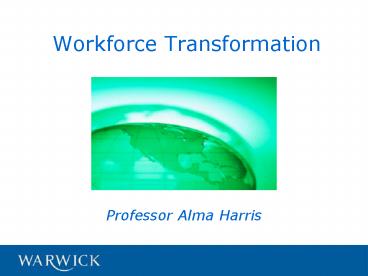Workforce Transformation - PowerPoint PPT Presentation
1 / 28
Title:
Workforce Transformation
Description:
I was struck by how inwardly focused the company had remained throughout the period ... Mackintosh its glamour and glow..now his investment and concern for the ... – PowerPoint PPT presentation
Number of Views:78
Avg rating:3.0/5.0
Title: Workforce Transformation
1
Workforce Transformation
- Professor Alma Harris
2
The Rise and Fall of Marks and Spencer and
how it rose again(Bevan 2001)
- I was struck by how inwardly focused the company
had remained throughout the period of change.
They were still all looking backwards.
3
Some Issues
- Complacency
- Resistance to change
- Rigid leadership structure
- Low trust
- No sense of shifting markets
- Transformation as necessity rather than part of
the natural process of change
4
From Desperation to Transformation
- Use of Data and Market information
- New Technologies
- Workforce restructuring
- Abandonment of unsuccessful stores, products and
practices - New niche market and slogan
- Flatter leadership - closer to customer
5
Transformation(Caldwell, 2007)
- Is significant, systematic and sustained change
that secures success.
6
Transforming Schools
- Is about securing success for all students in
all settings
7
Transforming Capacity Building
8
What we know about successful transformation
- Transformation is not a linear process.
- Schools can join the transformational process at
any point and at any stage of development - There are particular content and process levers
for transformation - The transformation process requires structural
and cultural change - The transformational process will differ in pace
and sequencing from school to school - Data plays a key role in transformational change
- Sustaining transformation requires different
levers - Leadership plays a key part in transformation
9
Key Question
- What type of leadership creates and sustains
organisational transformation?
10
Leadership is an extreme sport
11
In a world of global networks(Senge et al 2005)
- we face issues for which hierarchical leadership
is inherently inadequate
12
Leadership for Transformation
- From a culture where hierarchies and roles are
the dominant organisational architecture - To a culture where interactions and influence at
all levels are the drivers of change and new
knowledge.
13
The Google Economy
- The company lacks the usual layers of middle
management, the hierarchical structure found in
traditional companies is non-existent - David Vise (20057)
14
iCONYoung and Simon, 2005
- In the old days Steve always considered that a
small handful of anointed superstars were the
magic that gave Mackintosh its glamour and
glow..now his investment and concern for the
leadership of others is genuine
15
Leadership for transformation is distributed and
lateral
16
Leadership for transformation creates knowledge
17
But
- As leadership is distributed more within schools
and between schools do students achieve more?
18
Effects of of Leadership Distribution(Leithwood
et al 2006)
- Schools in the highest quintile of student
achievement attributed relatively high levels of
influence to all sources of leadership (i.e.
school teams, parents and students).
19
The Evidence (Harris 2003)
- teacher morale and self efficacy
- organisational development and change
- student learning outcomes
20
Yet teachers can do almost anything
- But they cant do everything!
21
Abandonment(Schumpter 1942)
- Transformation also means abandonment
22
What do we know about Workforce
Transformation(Harris 2007)
New Structures
New Roles
Learning
New Teams
New Ways of Working
23
But some forms of workforce transformation are
more effective than others
24
So we need to know more
- We need to capture and illuminate the process of
effective workforce transformation - This will be achieved by talking to heads and
other key respondents within the school about the
process of change in their school.
25
Research
- to ascertain how the school(s) are engaging with
workforce reform through the project and what
innovations they have implemented - to investigate the changes made and the impact of
those changes - to identify interesting practice worthy of
further scrutiny - to investigate trends relating to the
relationship between changes and achievement - to inquire into the schools views about
work-force reform - to identify sites and practice for deeper
investigation and follow up in a future research
study commencing April 2008.
26
Looking Forward
- How will workforce transformation be sustained in
your school? - What are the next steps in the transformation
process? - How did you decide on these?
- What difference do you think these will make? How
will you know? - What indicators of further transformational
change will you hope to see in your school?
27
Be Optimistic
28
alma.harris_at_warwick.ac.ukhttp//go.warwick.ac.u
k/distributed_leadership































